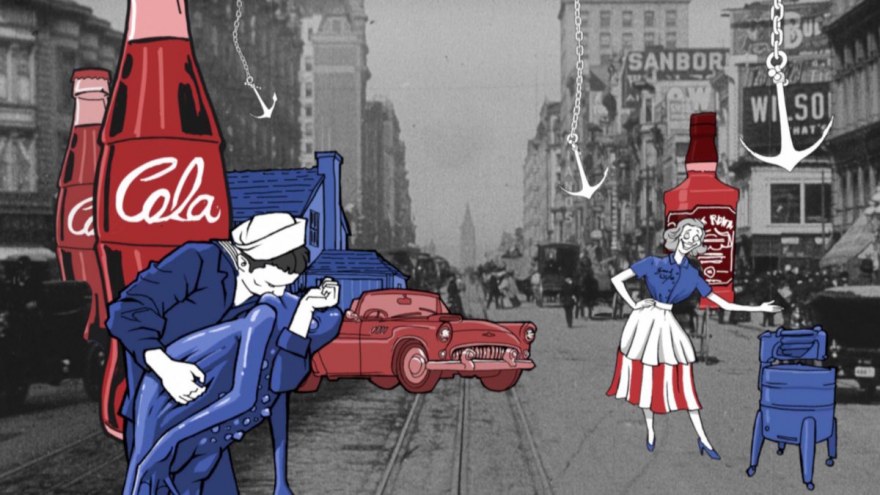Dinner with United Interest
Interview with Tim Weimann, director of United Interest
What was attracting in old films? Silent films? The industries and industrialization topics?
I always wanted to make a film about capitalism, but searched for the right approach. When I found the old film material of a street scene in San Francisco, I instantly knew that I wanted to combine it with animations. I personally love the contrast between the black and white footage and the coloured animation.
How did you build the animation in this respect? Is the loop always the same or did you make variations on it before adding the animation? How many times is the loop repeated?
Sorry! I do not totally understand this question. There is just one real footage sequence that is doubled, otherwise there are no loops. The production itself was challenging as the animation had to be matched to the motions of the real footage. For that reason no storyboard could be made to help to plan and stage the animation. This led to a very loose, straight ahead and associative workflow that was different to how I am normally used to work, but it was a lot of fun. Technically it was difficult too. The original material had no normal steady frame rate that we are used to today like 25 or 30 frames per second. Cameras in that time were operated by cranks. So the materials frame rate was between 12-15 frames per second, which meant that frames were sometimes doubled and sometimes not. To combine real footage with animation, you have to track the camera motion. This tracking process is best possible with a steady frame rate. I had to write a little program that compared each frame with the next one and deleted it, if it was a doubled one. Only then I could create the 2D animation and use a 3D program to place these animations in the virtual scene that I got from tracking the real footage.
Do you have a special relationship with USA? Why choosing this country?
To be honest I have no special relationship to the USA, but I do not need one, as we live in a globalised world. For us in Europe the presidential elections in the US are as important as the election of a local politician. The United States did not invent capitalism, but they developed it to the turbo capitalism that we have today. As it was quite successful over the last decades, it became a concept of living that all nations tried to copy in one or the other way. So if we want to understand capitalism and where it will lead us we have look here.
This film should not be misunderstood as an anti-American, but impeaches the current form of capitalism, a system that becomes more and more inhuman and that cannot be a forward-looking concept for mankind in general.
United Interest describes decades in a few minutes, why were you interested in giving this accelerated time story of a country’s History?
The film is not so much about the history of the United States, but about how capitalism changed over time in this country. The depicted historical events that do not connect to this subject itself are more a raster that helps to structure the events in time.
Why were you interested in the powerful’s impact, in the absorption of business magnates community to the people?
It is a fact that around ten percent of the world population own most of the worlds wealth and more and more people are falling below the poverty line each year. This is a systemic side effect of capitalism. This will become even worse in the coming years, when more and more work will be done by robots and artificial intelligence systems. We have to rethink our global system, if we want to live fair and treat everyone with respect and kindness. In an utopian version of a full automated future only the people that would want to work, would have to do it. The others could do what they would love most, as the heavy lifting would be done by machines. In an dystopian future we would not be able to overcome capitalistic principals. Less and less people would have a job and could earn their living. If until then we would not not already be in the middle of war and revolution, it would be here that this kind of capitalism would end, because who could buy all the goods then, when nobody would earn the money to pay for them anymore!?
What were the films that have inspired you the most this past year?
Snowden by Oliver Stone and Lo and Behold by Werner Herzog.
If you’ve already been to the Clermont-Ferrand, could you share with us an anecdote or story from the festival. If not, what are your expectations for this edition?
As I have never been to the festival so far, I do not know what to expect, but I heard that it shall always be a blast!
What are your projects?
At the moment I am working on a music video for the Swedish artist “Christoffer Wadensten“ aka Meadows.
United Interest is being shown in Lab Competition L3.








